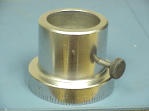
ACM Instruments are a member of the EEC Research Group for electroplating. We are actively involved with research into electroplating of Nickel and the resultant tribology studies. Using this experience we have added software to our instruments that makes fundamental and applied research into plating systems a whole lot easier. Our computer controlled instruments, incorporating a potentiostat, a galvanostat and a ZRA are ideal for electroplating experiments, being tough, versatile and accurate. A popular single channel choice is the Gill AC, this is a powerful, compact instrument, available at low cost and fully equipped with AC, DC and our special electroplating custom sequence software. Universities can buy the Gill AC with an enormous discount, this reflects ACM's confidence in the robustness of our equipment, over the period of our two year warranty students can inflict a tremendous amount of hard use... we very rarely have to fix them.
Commercial laboratories often need more than one channel when it comes to plating research. The choice from ACM is between parallel systems and a sequential instrument. Sequential instruments switch from one channel to the next, performing each test then moving on. The Gill 8 and Gill 12 represent our top of the range laboratory sequential instruments, these are an excellent choice if the budget does not justify a parallel system and time is not too limited. A parallel system is made up of individual Gill ACs or even Gill 8s controlled from one PC, supplied software is able to control all instruments at the same time, running any combination of tests in parallel, ideal where time is of the essence. Traditional electroplating research is usually concerned with DC methods, static and stepped potentials, albeit with a fast potentiostat. There is, however, a place for AC Impedance in the electroplater's tool kit. The AC impedance method is a powerful method to extract rate constants for electrochemical processes. One limitation to the usual DC methods is that reactions which do not achieve steady-state cannot be studied, e.g. an irreversible adsorption reaction which proceeds to completion of a monolayer and then stops. To catch this active adsorption region use our AC Voltammetry method, with acquisition of data one frequency per voltammetry cycle.
ACM understand your electroplating requirements. If more current is required we simply build the instrument to handle whatever is needed, the same with compliance voltage. Setting up complicated test waveforms is easy using our graphical waveform creator supplied to all of our electroplating customers. Finally our equipment looks good. The stylish case and brushed aluminium front panel gives a very professional look to the experimental bench, reassuring customers, company accountants, and yourself that you have purchased an instrument that is ideal for the job.
See Application Notes for more information on AC Impedance and Cyclic Voltammetry plus many more.
See Downloads for instrumentation datasheets.
